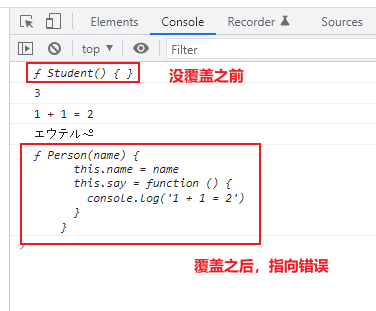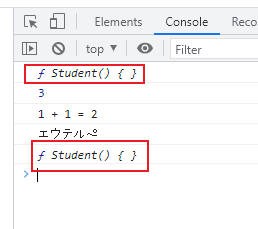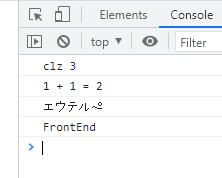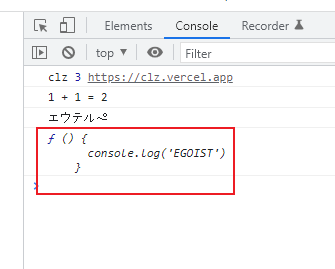JavaScript实现继承的六种方式
父类
function Person(name) {
this.name = name
this.say = function () {
console.log('1 + 1 = 2')
}
}
Person.prototype.listen = function () {
console.log('エウテルペ')
}
1. 原型链继承
将父类的实例作为子类的原型
function Person(name) {
this.name = name
this.say = function () {
console.log('1 + 1 = 2')
}
}
Person.prototype.listen = function () {
console.log('エウテルペ')
}
function Student() { }
Student.prototype = new Person() //关键
const stu = new Student()
stu.grade = 3
console.log(stu.grade) // 3
stu.say() // 1 + 1 = 2
stu.listen() // エウテルペ
优点:
-
简单易实现
-
父类新增原型方法/原型属性,子类都能访问
-
实例是子类的实例也是父类的实例
stu instanceof Student // true stu instanceof Person // true
缺点:
- 为子类新增属性和方法,不能在构造函数中
- 无法实现多继承
- 创建子类实例时,不能向父类构造函数传参数
- 所有新实例都会共享父类实例的属性。(原型上的属性是共享的,一个实例修改了原型属性,另一个实例的原型属性也会被修改!)
存在的问题:
-
prototype里有个属性constructor指向构造函数本身,但是,Student的原型已经被父类的实例取代了,所以指向也不正确,所以需要修复构造函数指向(这里网上的教程只是对组合继承、寄生组合式继承进行了修复,不知道是不是因为这个不常用的关系)function Student() { } console.log(Student.prototype.constructor) Student.prototype = new Person() //关键 const stu = new Student() stu.grade = 3 console.log(stu.grade) // 3 stu.say() // 1 + 1 = 2 stu.listen() // エウテルペ console.log(Student.prototype.constructor)
解决问题
Student.prototype.constructor = Student

2. 借用构造函数继承
在一个类中执行另一个类的构造函数,通过call函数设置this的指向,这样就可以得到另一个类的所有属性
function WebsiteMaster(site) {
this.site = site
}
function Student(name, grade, site) {
Person.call(this, name)
WebsiteMaster.call(this, site)
this.grade = grade
}
const stu = new Student('clz', 3, 'https://clz.vercel.app')
console.log(stu.name, stu.grade, stu.site) // clz, 3, https://clz.vercel.app
stu.say() // 1 + 1 = 2
stu.listen() // Uncaught TypeError: stu.listen is not a function
优点:
- 创建子类实例时,可以向父类传递参数
- 可以实现多继承(call多个对象)
- 不需要修复构造函数指向
缺点:
-
方法在构造函数中定义,无法复用
-
只能继承父类的实例属性,不能继承原型属性、方法
-
实例并不是父类的实例,而只是子类的实例
stu instanceof Student // true stu instanceof Person // false继承继着不再是人了(笑)
3. 原型式继承
为父类实例添加属性、方法,作为子类实例。
道格拉斯·克罗克福德在一篇文章中介绍了一种实现继承的方法,这种方法并没有使用严格意义上的构造函数。它的想法是借助原型可以基于已有的对象创建新对象,同时还不必因此创建自定义类型。为了达到这个目的,他给出了如下函数。
function object(o){ function F() {} F.prototype = o; return new F(); }
function object(o) {
function F() { }
F.prototype = o;
return new F();
}
const person = new Person('clz')
const stu = object(person)
stu.grade = 3
stu.study = function () {
console.log('FrontEnd')
}
console.log(stu.name, stu.grade) // clz, 3
stu.say() // 1 + 1 = 2
stu.listen() // エウテルペ
stu.study() // FrontEnd

优点:
- 感觉没啥优点,不太像继承
缺点:
- 不支持多继承
- 实例是父类的实例
4. 寄生式继承
为父类实例添加属性、方法,作为子类实例。(原理和原型式继承一样)
function object(o) {
function F() { }
F.prototype = o;
return new F();
}
function Student(name, grade) {
const person = object(new Person(name))
person.grade = grade
person.study = function () {
console.log('FrontEnd')
}
return person
}
const stu = new Student('clz', 3)
console.log(stu.name, stu.grade) // clz, 3
stu.say() // 1 + 1 = 2
stu.listen() // エウテルペ
stu.study() // FrontEnd
优点:
- 有了子类的雏形,但是换汤不换药,原理和原型式继承一样
缺点:
-
不支持多继承
-
实例是父类的实例,不是子类的实例(因为只是在父类的实例上添加属性、方法而已)
stu instanceof Student // false stu instanceof Person // true
5. 组合继承
原型链继承+借用构造函数继承
function WebsiteMaster(site) {
this.site = site
}
function Student(name, grade, site) {
Person.call(this, name) // 继承属性
WebsiteMaster.call(this, site)
this.grade = grade
}
Student.prototype = new Person() // 继承方法
Student.prototype.constructor = Student
const stu = new Student('clz', 3, 'https://clz.vercel.app')
console.log(stu.name, stu.grade, stu.site) // clz, 3, https://clz.vercel.app
stu.say() // 1 + 1 = 2
stu.listen() // エウテルペ
console.log(stu.constructor)
优点:
- 可以继承实例属性、方法,也可以继承原型属性、方法
- 可传参、可复用
- 实例既是子类的实例,也是父类的实例
缺点:
- 调用了两次父类构造函数,耗内存
- 需要修复构造函数指向
6. 寄生组合式继承
通过Object.create()来代替给子类原型赋值的过程,解决了两次调用父类构造函数的问题
function WebsiteMaster(site) {
this.site = site
}
function Student(name, grade, site) {
Person.call(this, name) // 继承属性
WebsiteMaster.call(this, site)
this.grade = grade
}
Student.prototype = Object.create(Person.prototype) // 继承方法
Student.prototype.constructor = Student // 修复构造函数指向
const stu = new Student('clz', 3, 'https://clz.vercel.app')
console.log(stu.name, stu.grade, stu.site) // clz, 3, https://clz.vercel.app
stu.say() // 1 + 1 = 2
stu.listen() // エウテルペ
有人可能会提出:为什么不可以直接把父类原型赋值给子类原型来实现呢?
这是因为直接赋值的话,那就是引用关系。下面就来看看
function WebsiteMaster(site) {
this.site = site
}
function Student(name, grade, site) {
Person.call(this, name) // 继承属性
WebsiteMaster.call(this, site)
this.grade = grade
}
Student.prototype = Person.prototype // 继承方法
Student.prototype.constructor = Student // 修复实例
const stu = new Student('clz', 3, 'https://clz.vercel.app')
console.log(stu.name, stu.grade, stu.site) // clz, 3, https://clz.vercel.app
stu.say() // 1 + 1 = 2
stu.listen() // エウテルペ
Student.prototype.listen = function () {
console.log('EGOIST')
}
console.log(Person.prototype.listen)

可以看到,修改Student原型上的方法时,Person的原型上的也会跟着变化。
**
Object.create()**方法创建一个新对象,使用现有的对象来提供新创建的对象的__proto__。所以,此时修改
Student原型上的方法时,Person的原型上的不会跟着变化。
es6之前没有Object.create()方法,可以自己实现(实际就是原型式继承的关键函数)
关键:
- 接受一个对象obj
- 返回一个新对象newObj
- 让
newObj.__proto__ === obj
function object(obj) {
function F() {} // 新的构造函数
F.prototype = obj; // 继承传入的参数obj
return new F(); // 返回新的函数对象
}
参考链接:






















 741
741











 被折叠的 条评论
为什么被折叠?
被折叠的 条评论
为什么被折叠?








